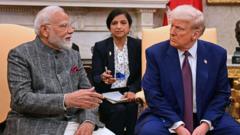In a recent statement, President Donald Trump indicated that India could be subjected to tariffs up to 25% if a trade agreement with the United States is not established by this week. During a press interaction, Trump confirmed, "Yeah, I think so," when probed about the likelihood of higher tariffs in the absence of a deal. The US has set a deadline of August 1 for India and several other countries to finalize their agreements to avoid increased tariff rates.
Discussions between Indian and US officials have progressed for months, traveling through cycles of optimism and caution regarding an imminent announcement. Trump remarked on the nature of trade between the two nations, noting, "India has been a good friend, but [it has] charged basically more tariffs than almost any other country." He emphasized his administration's commitment to addressing these imbalances in trade, stating, "But now I'm in charge, and you just can't do that."
The US president's concerns stem from India's high tariff rates, prompting him to label it as a "tariff king" and a significant player in trade abuses. Thus far, he has not enacted a formal letter to India declaring a new tariff rate as he has with numerous other trading partners.
Historically, US tariffs on Indian goods have reached as high as 27%, although this move was put on hold to allow time for negotiations. Both parties are aware that agriculture and dairy remain contentious points in talks. Currently, the US seeks greater access to India's agricultural sector, a lucrative market yet one that India fiercely defends in light of food security and the livelihoods of small farmers.
Indian Commerce Minister Piyush Goyal emphasized the sensitivities surrounding India's agricultural protections, asserting that the government will ensure farmer interests are prioritized. He expressed optimism about the ongoing negotiations, indicating substantial progress and a hope for a premature celebration of a "very consequential partnership."
Trade relations between India and the US saw bilateral exchange ballooning to $190 billion in 2024, the highest before aims were set to double that figure to $500 billion. Meanwhile, despite India’s recent reductions in tariffs on various goods, the US still navigates a trade deficit of $45 billion with India, a gap Trump aims to minimize.



















